381. Levaillant's Cuckoo (Formerly known as Striped Cuckoo) Clamator levaillantii (Gestreepte Nuwejaarsvoël)
Order: Cuculiformes. Family: Cuculidae
Description
37.5 cm. Black above, faintly glossed bluish or greenish. Black crest. White patch on black wings. Dull white below, streaked on throat and breast, less obvious streaking on flanks and thighs.
Adult pied morph: Head and upper parts black with greenish sheen, most apparent on wing, tail coverts and tail. Tail strongly graduated, outer 2 pairs of rectrices broadly tipped white in fresh plumage. Primaries black, white on basal half visible on folded wing as conspicuous, broad (20-30 mm) white patch. Underparts creamy or greyish white, streaked black on throat and breast, streaks narrower and more widely spaced on belly. Much individual variation in streaking below; throat and breast lightly or heavily streaked, thighs and flanks plain or variably streaked. Bill black. Eyes brown. Legs and feet bluish grey.
Juveniles are brown to rufous on upperparts, have dark brown wings with a white patch, a grey-brown tail and are whitish to buffy on underparts with dull brown chin to breast.
Similar species: Jacobin Cuckoo is smaller and unstreaked on underparts.
Distribution
Across much of sub-Saharan Africa, excluding arid areas. In southern Africa it is uncommon in northern Namibia, northern and southern Botswana, Zimbabwe, Mozambique, Swaziland and north-eastern South Africa.
Habitat
Savanna and woodland.
Movement and migrations
Intra-African breeding migrant, arriving in southern Africa from October-November, going through its full breeding cycle before departing around March-April.
Diet
It eats mainly caterpillars, occasionally supplemented with other insects or fruit.
Breeding
It is a brood parasite, meaning that it lays its eggs in other birds nests. The host, thinking that the egg is its own, incubates the egg and cares for the chick. Southern Pied Babbler, Bare-cheeked Babbler, Hartlaub's Babbler, Arrow-marked Babbler have been recorded to be parasitized by the Levaillant's Cuckoo. Egg-laying season is from October-May. It is difficult for the female to lay an egg in the host nest, as they usually attack cuckoos vigorously. In order to distract them, both sexes fly around acrobatically, provoking a group attack from the hosts. The male takes the brunt of the attack, while the female endeavours to lay an egg in the nest, after which both sexes retreat, with the host birds hot in pursuit. The chick hatches after an incubation period of about 11-13 days, remaining in the nest for around 9-10 days. Unlike many other cuckoos, the chick does not kill the host nestlings. It learns to fly soon after leaving, becoming fully independent at about 29-42 days old.
Call
The call is a low ringing kuwu-weer, kuwu-weer... and an excited ku-wi-wi-wi. Listen to Bird Call.
Status
Locally common summer visitor.
Africa Wild Bird Book
- nan
- Posts: 26476
- Joined: Thu May 31, 2012 9:41 pm
- Country: Switzerland
- Location: Central Europe
- Contact:
Levaillant's Cuckoo Photos
381. Levaillant's Cuckoo Clamator levaillantii

 © Duke
© Duke
Kruger National Park
 © leachy
© leachy
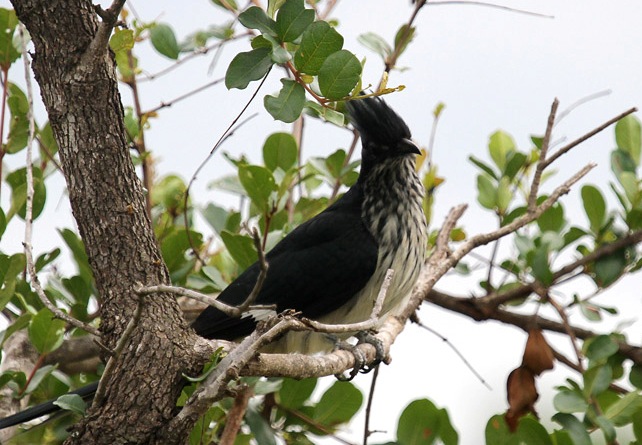 © leachy
© leachy
 © leachy
© leachy
Links:
Species text Sabap1
Sabap2

 © Duke
© DukeKruger National Park
 © leachy
© leachy © leachy
© leachy © leachy
© leachy Links:
Species text Sabap1
Sabap2
Kgalagadi lover… for ever
https://safrounet.piwigo.com/
https://safrounet.piwigo.com/
Jacobin Cuckoo
382. Jacobin Cuckoo Clamator jacobinus (Bontnuwejaarsvoel)
Order: Cuculiformes. Family: Cuculidae
Description
33 cm. This medium sized, slim black and white cuckoo. Adults have a prominent black crest and a long, graduated tail. The white wing patch on the black wing and the pattern make it unmistakable even in flight.
They occur in two distinct colour morphs: Adults of the light morph are black above with white underparts, whereas the dark morph is completely black except for a small white wing patch which occurs in both morphs.
Juveniles are browner above and yellowish-white below.
Distribution
Fairly common and widespread, with occurring from India to Arabia south to sub-Saharan Africa, avoiding equatorial lowland forest. In southern Africa it is fairly common in central and northern Namibia, Botswana, Zimbabwe, Mozambique and South Africa (largely excluding the arid Karoo).
Habitat
It generally prefers Acacia and mixed savanna woodland, but it may also occupy valley bushveld, coastal forest and Miombo woodland.
Movements and migrations
Intra-African breeding migrant, with complex movements across its distribution range. It normally arrives in southern Africa in October to breed, and usually leaves by April, although it sometimes stays for the rest of the year.
Diet
Feeds mainly on caterpillars, doing most of its foraging by hopping from branch to branch, snatching insects from the foliage.
Breeding It is a brood parasite, meaning that it lays its eggs in other birds nests. The host, thinking that the egg is its own, incubates the egg and cares for the chick. Major hosts are Pycnonotus tricolor (Dark-capped Bulbul), Pycnonotus capensis (Cape Bulbul), Lanius collaris (Common Fiscal), Andropadus importunus (Sombre Greenbul), Pycnonotus nigricans (African Red-eyed Bulbul). Egg-laying season is from October-April, peaking from November-January. It lays one egg per nest, laying a total of about 25 eggs in one breeding season. Both sexes are involved in egg-laying - the male perches near the host's nest, calling loudly in order to get the attention of the hosts away from the female. She in the meantime flies into the nest, lays an egg and flies out again, usually abstaining from destroying the hosts eggs. The chick hatches after an incubation period of about 11-13 days, remaining in the nest for roughly 17 days. It learns to fly soon after leaving, becoming fully independent at 33 days old.
Call
A shrill klee-klee-kleeo-kleeo. Listen to Bird Call.
Status
Common summer visitor.
Order: Cuculiformes. Family: Cuculidae
Description
33 cm. This medium sized, slim black and white cuckoo. Adults have a prominent black crest and a long, graduated tail. The white wing patch on the black wing and the pattern make it unmistakable even in flight.
They occur in two distinct colour morphs: Adults of the light morph are black above with white underparts, whereas the dark morph is completely black except for a small white wing patch which occurs in both morphs.
Juveniles are browner above and yellowish-white below.
Distribution
Fairly common and widespread, with occurring from India to Arabia south to sub-Saharan Africa, avoiding equatorial lowland forest. In southern Africa it is fairly common in central and northern Namibia, Botswana, Zimbabwe, Mozambique and South Africa (largely excluding the arid Karoo).
Habitat
It generally prefers Acacia and mixed savanna woodland, but it may also occupy valley bushveld, coastal forest and Miombo woodland.
Movements and migrations
Intra-African breeding migrant, with complex movements across its distribution range. It normally arrives in southern Africa in October to breed, and usually leaves by April, although it sometimes stays for the rest of the year.
Diet
Feeds mainly on caterpillars, doing most of its foraging by hopping from branch to branch, snatching insects from the foliage.
Breeding It is a brood parasite, meaning that it lays its eggs in other birds nests. The host, thinking that the egg is its own, incubates the egg and cares for the chick. Major hosts are Pycnonotus tricolor (Dark-capped Bulbul), Pycnonotus capensis (Cape Bulbul), Lanius collaris (Common Fiscal), Andropadus importunus (Sombre Greenbul), Pycnonotus nigricans (African Red-eyed Bulbul). Egg-laying season is from October-April, peaking from November-January. It lays one egg per nest, laying a total of about 25 eggs in one breeding season. Both sexes are involved in egg-laying - the male perches near the host's nest, calling loudly in order to get the attention of the hosts away from the female. She in the meantime flies into the nest, lays an egg and flies out again, usually abstaining from destroying the hosts eggs. The chick hatches after an incubation period of about 11-13 days, remaining in the nest for roughly 17 days. It learns to fly soon after leaving, becoming fully independent at 33 days old.
Call
A shrill klee-klee-kleeo-kleeo. Listen to Bird Call.
Status
Common summer visitor.
Jacobin Cuckoo Photos
382. Jacobin Cuckoo Clamator jacobinus
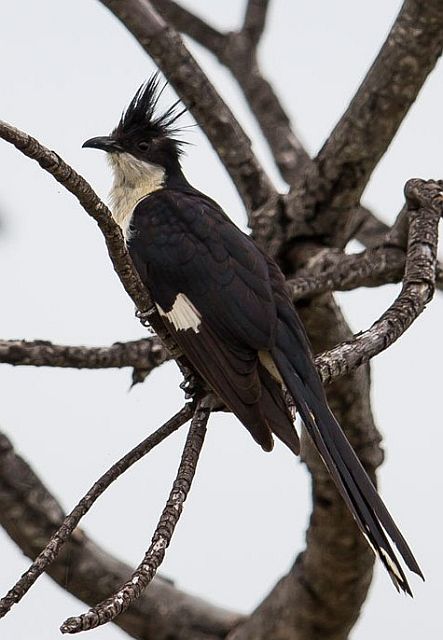 © Pumbaa
© Pumbaa
Kruger National Park
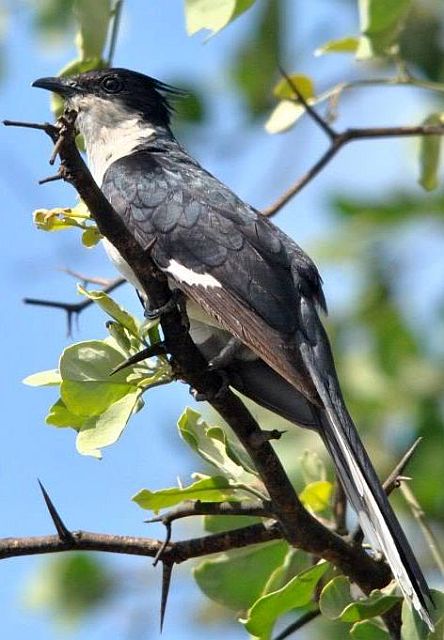 © lowveldboy
© lowveldboy
Pale morph
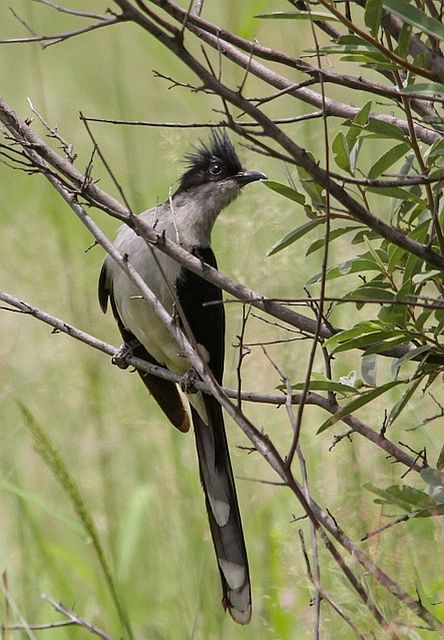 © Super Mongoose
© Super Mongoose
Vaalkop Dam Nature Reserve, North West Province, South Africa
 © leachy
© leachy
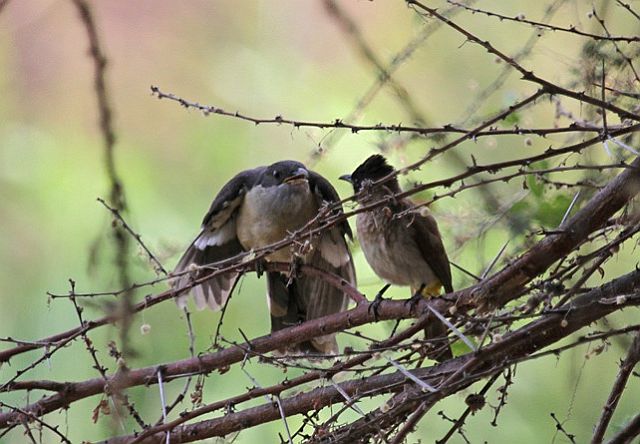 © leachy
© leachy
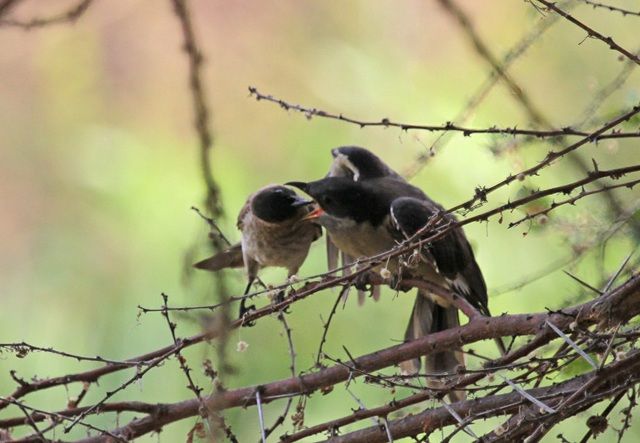 © leachy
© leachy
Dark-capped Bulbul feeding Jacobin Cuckoo
 © BluTuna
© BluTuna
Arrow-marked Babbler feeding Jacobin Cuckoo
 © BluTuna
© BluTuna
Kruger National Park, Tsendze
Links:
Species text Sabap1
Sabap2
 © Pumbaa
© PumbaaKruger National Park
 © lowveldboy
© lowveldboyPale morph
 © Super Mongoose
© Super MongooseVaalkop Dam Nature Reserve, North West Province, South Africa
 © leachy
© leachy © leachy
© leachy © leachy
© leachyDark-capped Bulbul feeding Jacobin Cuckoo
 © BluTuna
© BluTunaArrow-marked Babbler feeding Jacobin Cuckoo
 © BluTuna
© BluTunaKruger National Park, Tsendze
Links:
Species text Sabap1
Sabap2
- nan
- Posts: 26476
- Joined: Thu May 31, 2012 9:41 pm
- Country: Switzerland
- Location: Central Europe
- Contact:
Diderick Cuckoo
386. Diderick Cuckoo Chrysococcyx caprius (Diederikkie)
Order: Cuculiformes. Family: Cuculidae
Description
It is a one of the smaller cuckoos, with a length of about 20 cm; metallic green above and with whitish underparts. They have a broken white eyestripe, a green moustauchial stripe, and green outer tail feathers adorned with white spots. Eyes are red (not brown); the bill black and legs and feet grey.
Adult male: Head to back metallic green, with bronze patches on back of head and nape. Supercilium, forehead and median crown stripe white. Tail dark green; all except central pair of rectrices with white tips and white spots along both edges. Upper wing coverts glossy bronze-green, with large white spots. Flight feathers blackish, with white bars across inner webs of primaries. Underwing coverts and undersides of flight feathers dark, with white bars. Underparts white; flanks, thighs and undertail coverts barred green. Bill black. Eyes and eye ring red. Legs and feet grey.
Adult female: Similar to male, but duller, with or without white forehead. Upper parts green, rufous or intermediate, but usually rufous or bronze; upper wing coverts with white to buff or rufous spots. Tail dark green, rectrices with rufous spots and notches; second to fourth pairs with broad rufous bars. Underparts white to buff, throat and breast usually washed brown; breast often lightly streaked or barred dull green or bronze. Bill black. Eyes hazel to reddish brown, eye ring brown.
Juvenile: Sexes alike. Upper parts dull green, bright rufous or intermediate, with green and rufous barring; some with rufous restricted to crown. Upper wing coverts with pale spots (except in rufous birds). Underparts white; throat with dark greenish or rufous streaks. Breast and belly with blackish or dark green spots. Bill coral red. Eyes grey to brown. While still in juv plumage, eye ring of male becomes red. Legs and feet dark brown.
Similar species: Male easily distinguished from similar Klass's Cuckoo by the broad white eye-stripe, white spots on forewings and by its red, not brown eyes. Female differs from female Klass's Cuckoo by being much greener above and whiter below, with much reduced barring on the flanks and having white spots on the forewings. Red bill of juv Diderick Cuckoo separates it from other African Chrysococcyx spp of all ages.
Distribution
Almost all over Southern Africa.
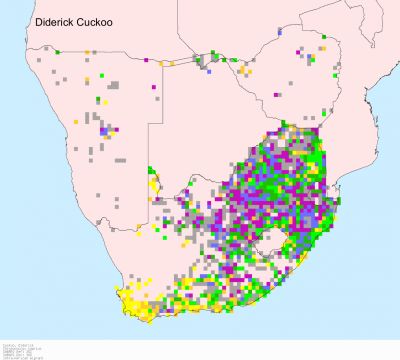
Habitat
Woodland, savanna, grassland and suburban gardens.
Movements and migrations
Diderick Cuckoos are intra-African migrants and arrive in southern Africa from central or east Africa in September/October and depart again in March/April.
Diet
It eats invertebrates, mainly caterpillars, but also termites and even the eggs of its host. It typically forages in the foliage of trees and bushes, gleaning prey from leaves and stems, and occasionally flying down to the ground to pick up a prey item.
Breeding
A brood parasite; hosts include Red Bishop, Cape Sparrow, Southern Masked-Weaver, Village Weaver, Cape Weaver and Cape Wagtail. Egg-laying season is from October to March. Before laying the egg, it waits for the potential host to leave the nest and than flies in to inspect it. If it is suitable then it will either throw the existing eggs out the nest, or carry them to a nearby perch to eat them. Once the eggs have been removed, it lays one egg (rarely two). The cuckoo female is often mobbed and chased by the host bird. It lays 3-5 eggs a day, and 20-24 eggs are laid in the 10-12 week breeding season.
It is sometimes killed by its potential host; in one example a male was mobbed and killed by Southern masked-weavers. Also, females sometimes get stuck in the nest entrance and are pecked to death by Lesser masked-weavers, Within the first three days of hatching, the chick eats any other eggs or chicks that weren't present at the time of laying. It is fed by the host, staying in the nest for about 19-22 days, after which the chick remains with its adoptive parents for about 21 more days.
Call
A loud and persistent deed-deed-deed-deed-er-ick. Listen to Bird Call
Status
Breeding migrant. Common.
Order: Cuculiformes. Family: Cuculidae
Description
It is a one of the smaller cuckoos, with a length of about 20 cm; metallic green above and with whitish underparts. They have a broken white eyestripe, a green moustauchial stripe, and green outer tail feathers adorned with white spots. Eyes are red (not brown); the bill black and legs and feet grey.
Adult male: Head to back metallic green, with bronze patches on back of head and nape. Supercilium, forehead and median crown stripe white. Tail dark green; all except central pair of rectrices with white tips and white spots along both edges. Upper wing coverts glossy bronze-green, with large white spots. Flight feathers blackish, with white bars across inner webs of primaries. Underwing coverts and undersides of flight feathers dark, with white bars. Underparts white; flanks, thighs and undertail coverts barred green. Bill black. Eyes and eye ring red. Legs and feet grey.
Adult female: Similar to male, but duller, with or without white forehead. Upper parts green, rufous or intermediate, but usually rufous or bronze; upper wing coverts with white to buff or rufous spots. Tail dark green, rectrices with rufous spots and notches; second to fourth pairs with broad rufous bars. Underparts white to buff, throat and breast usually washed brown; breast often lightly streaked or barred dull green or bronze. Bill black. Eyes hazel to reddish brown, eye ring brown.
Juvenile: Sexes alike. Upper parts dull green, bright rufous or intermediate, with green and rufous barring; some with rufous restricted to crown. Upper wing coverts with pale spots (except in rufous birds). Underparts white; throat with dark greenish or rufous streaks. Breast and belly with blackish or dark green spots. Bill coral red. Eyes grey to brown. While still in juv plumage, eye ring of male becomes red. Legs and feet dark brown.
Similar species: Male easily distinguished from similar Klass's Cuckoo by the broad white eye-stripe, white spots on forewings and by its red, not brown eyes. Female differs from female Klass's Cuckoo by being much greener above and whiter below, with much reduced barring on the flanks and having white spots on the forewings. Red bill of juv Diderick Cuckoo separates it from other African Chrysococcyx spp of all ages.
Distribution
Almost all over Southern Africa.

Habitat
Woodland, savanna, grassland and suburban gardens.
Movements and migrations
Diderick Cuckoos are intra-African migrants and arrive in southern Africa from central or east Africa in September/October and depart again in March/April.
Diet
It eats invertebrates, mainly caterpillars, but also termites and even the eggs of its host. It typically forages in the foliage of trees and bushes, gleaning prey from leaves and stems, and occasionally flying down to the ground to pick up a prey item.
Breeding
A brood parasite; hosts include Red Bishop, Cape Sparrow, Southern Masked-Weaver, Village Weaver, Cape Weaver and Cape Wagtail. Egg-laying season is from October to March. Before laying the egg, it waits for the potential host to leave the nest and than flies in to inspect it. If it is suitable then it will either throw the existing eggs out the nest, or carry them to a nearby perch to eat them. Once the eggs have been removed, it lays one egg (rarely two). The cuckoo female is often mobbed and chased by the host bird. It lays 3-5 eggs a day, and 20-24 eggs are laid in the 10-12 week breeding season.
It is sometimes killed by its potential host; in one example a male was mobbed and killed by Southern masked-weavers. Also, females sometimes get stuck in the nest entrance and are pecked to death by Lesser masked-weavers, Within the first three days of hatching, the chick eats any other eggs or chicks that weren't present at the time of laying. It is fed by the host, staying in the nest for about 19-22 days, after which the chick remains with its adoptive parents for about 21 more days.
Call
A loud and persistent deed-deed-deed-deed-er-ick. Listen to Bird Call
Status
Breeding migrant. Common.
Kgalagadi lover… for ever
https://safrounet.piwigo.com/
https://safrounet.piwigo.com/
- nan
- Posts: 26476
- Joined: Thu May 31, 2012 9:41 pm
- Country: Switzerland
- Location: Central Europe
- Contact:
Diderick Cuckoo Photos
386. Diderick Cuckoo Chrysococcyx caprius
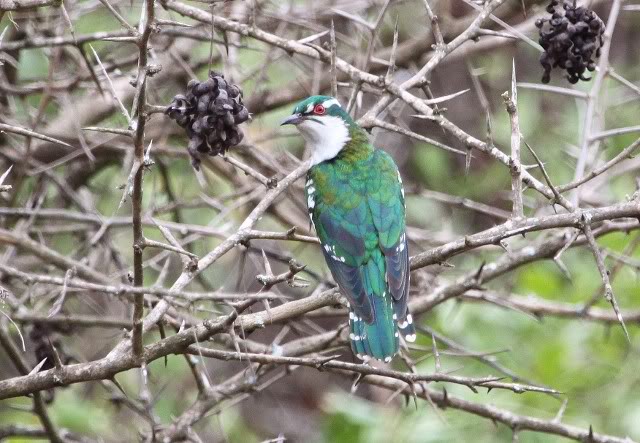 © nan
© nan
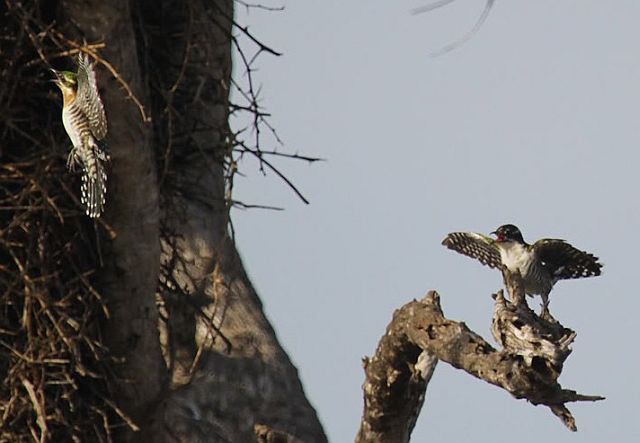 © leachy
© leachy
 © leachy
© leachy
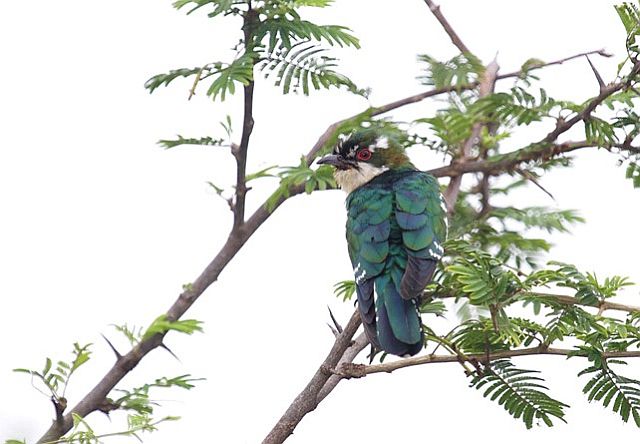 © leachy
© leachy
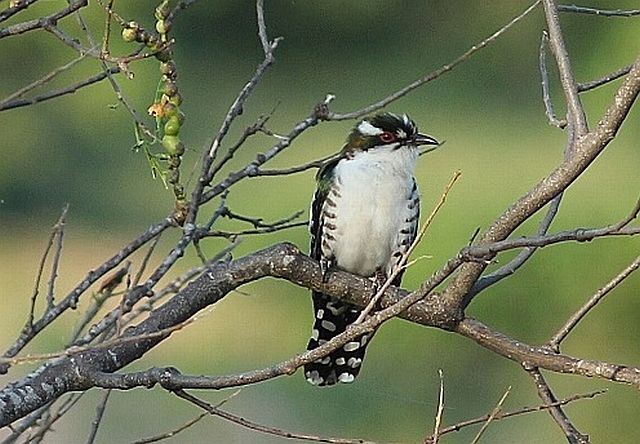 © Amoli
© Amoli
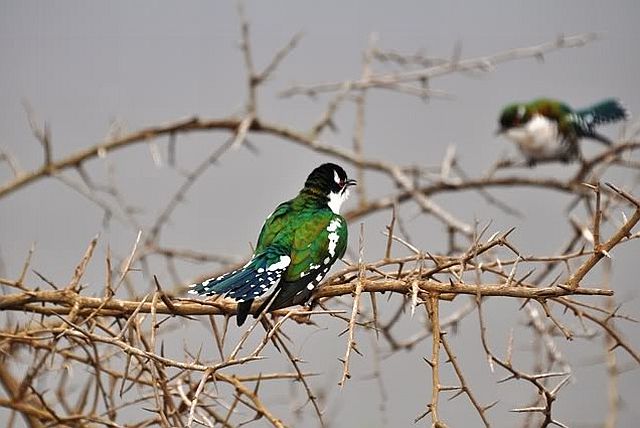 © JustN@ature
© JustN@ature
Male
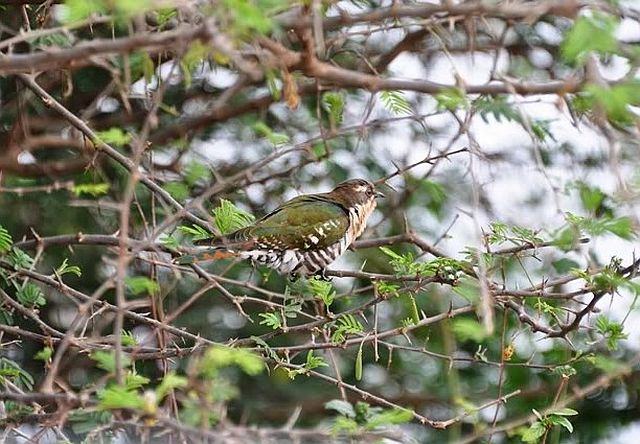 © JustN@ature
© JustN@ature
Female
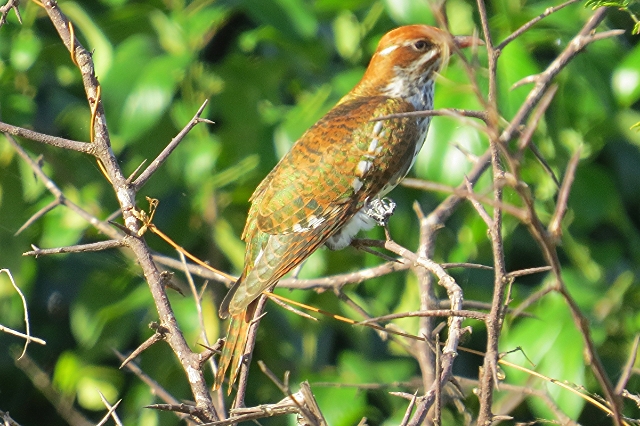 © Tina
© Tina
Juvenile, Kruger National Park, H4-1
Links:
Species text Sabap1: http://sabap2.adu.org.za/docs/sabap1/386.pdf
Sabap2: http://sabap2.adu.org.za/species_info.p ... #menu_left
Roberts online
Paul A. Johnsgard Foundation. The Avian Brood Parasites: Deception at the Nest
Rael Loon, Hélène Loon. Sasol Birds: The Inside Story
 © nan
© nan © leachy
© leachy © leachy
© leachy © leachy
© leachy © Amoli
© Amoli © JustN@ature
© JustN@atureMale
 © JustN@ature
© JustN@atureFemale
 © Tina
© TinaJuvenile, Kruger National Park, H4-1
Links:
Species text Sabap1: http://sabap2.adu.org.za/docs/sabap1/386.pdf
Sabap2: http://sabap2.adu.org.za/species_info.p ... #menu_left
Roberts online
Paul A. Johnsgard Foundation. The Avian Brood Parasites: Deception at the Nest
Rael Loon, Hélène Loon. Sasol Birds: The Inside Story
Kgalagadi lover… for ever
https://safrounet.piwigo.com/
https://safrounet.piwigo.com/
Klaas's Cuckoo
385. Klaas's Cuckoo Chrysococcyx klaas (Meitjie)
Order: Cuculiformes. Family: Cuculidae
Description
Size: 18 cm. Weight: 26 g. Small, brightly coloured cuckoo with glossy green or bronze upperparts. Males and females both have a small white post-ocular patch. Dark eyes. Green bill. Small white patch behind eye and green half collar extending onto sides of breast diagnostic. Lacks white wing spots of Diderick Cuckoo
Adult male: Glossy-green upperparts with few markings and a white patch behind the eye. Underparts plain white with dark green patches on sides of breast. Clean white outer tail. Viewed in flight, the male is largely white with dark primaries.
Females have a bronze-brown body, greenish wing coverts and faintly barred white underparts. In flight, females appear mostly brown.
Immature is similare to the female, but more heavily barred above and below, with a sudued bar behind the eye and a dark bill.
Similar species: Male differs from the very similar male Diederick Cuckoo by having only a small amount of white behind the eye, not white markings on the wings and a brown (not red) eye. Female differs from the very similar female Diederick Cuckoo by having finer more extensive barring on the flanks and chest, and by lacking white markings.
Distribution
Fairly common across sub-Saharan Africa, absent only from arid desert. In southern Africa it is fairly common in central and northern Namibia, northern and eastern Botswana, Zimbabwe, Mozambique, Swaziland and southern and eastern South Africa.
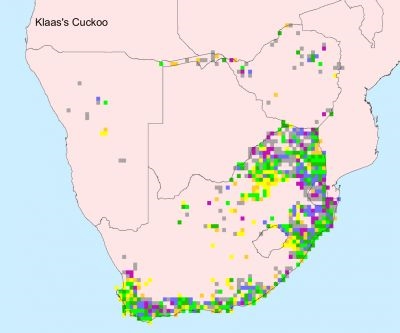
Habitat
It generally prefers open broad-leaved woodland, especially miombo and Mopane woodland, but it also occupies dense Acacia thickets, forest edges, gardens and alien tree stands around farmsteads.
Diet
Mainly insectivorous, specializing in butterflies and caterpillars. It usually forages in the foliage of trees or bushes, taking insects from leaves and occasionally hawking a flying insect.
Breeding
It is a brood parasite, meaning that it lays its eggs in other birds nests. The host, thinking that the egg is its own, incubates the egg and cares for the chick. Egg-laying season is year-round, peaking from October-January. It lays one egg per nest, laying roughly 24 eggs in one breeding season. The chicks usually hatch after an incubation period of about 11-12 days. Soon after hatching, the chick evicts any of the host's chicks or eggs that are present in the nest. It stays in the nest for about 19-21 days, after which it remains with the host bird for up to 25 days.
Call
Characteristic simple whistles repeated over and over by male from song-post for up to 20min a time: huee-jee. Listen to Bird Call.
Status
Fairly common br intra-African migrant (Sept-Apr), some birds overwintering.
Order: Cuculiformes. Family: Cuculidae
Description
Size: 18 cm. Weight: 26 g. Small, brightly coloured cuckoo with glossy green or bronze upperparts. Males and females both have a small white post-ocular patch. Dark eyes. Green bill. Small white patch behind eye and green half collar extending onto sides of breast diagnostic. Lacks white wing spots of Diderick Cuckoo
Adult male: Glossy-green upperparts with few markings and a white patch behind the eye. Underparts plain white with dark green patches on sides of breast. Clean white outer tail. Viewed in flight, the male is largely white with dark primaries.
Females have a bronze-brown body, greenish wing coverts and faintly barred white underparts. In flight, females appear mostly brown.
Immature is similare to the female, but more heavily barred above and below, with a sudued bar behind the eye and a dark bill.
Similar species: Male differs from the very similar male Diederick Cuckoo by having only a small amount of white behind the eye, not white markings on the wings and a brown (not red) eye. Female differs from the very similar female Diederick Cuckoo by having finer more extensive barring on the flanks and chest, and by lacking white markings.
Distribution
Fairly common across sub-Saharan Africa, absent only from arid desert. In southern Africa it is fairly common in central and northern Namibia, northern and eastern Botswana, Zimbabwe, Mozambique, Swaziland and southern and eastern South Africa.

Habitat
It generally prefers open broad-leaved woodland, especially miombo and Mopane woodland, but it also occupies dense Acacia thickets, forest edges, gardens and alien tree stands around farmsteads.
Diet
Mainly insectivorous, specializing in butterflies and caterpillars. It usually forages in the foliage of trees or bushes, taking insects from leaves and occasionally hawking a flying insect.
Breeding
It is a brood parasite, meaning that it lays its eggs in other birds nests. The host, thinking that the egg is its own, incubates the egg and cares for the chick. Egg-laying season is year-round, peaking from October-January. It lays one egg per nest, laying roughly 24 eggs in one breeding season. The chicks usually hatch after an incubation period of about 11-12 days. Soon after hatching, the chick evicts any of the host's chicks or eggs that are present in the nest. It stays in the nest for about 19-21 days, after which it remains with the host bird for up to 25 days.
Call
Characteristic simple whistles repeated over and over by male from song-post for up to 20min a time: huee-jee. Listen to Bird Call.
Status
Fairly common br intra-African migrant (Sept-Apr), some birds overwintering.
Klaas's Cuckoo Photos
385. Klaas's Cuckoo Chrysococcyx klaas
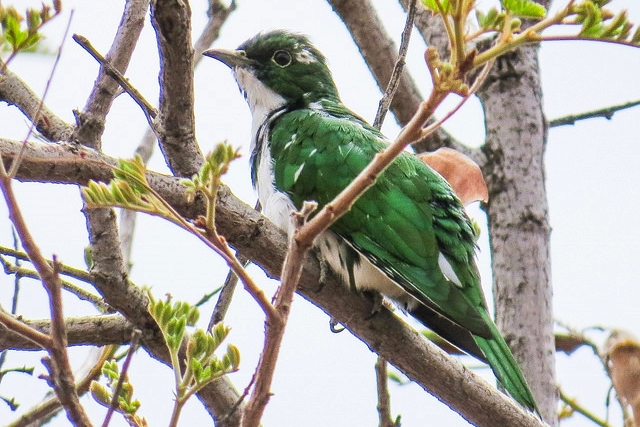 © steamtrainfan
© steamtrainfan
Pilanesberg, Kubu Picnic Site
 © BluTuna
© BluTuna
Kruger National Park, Olifants
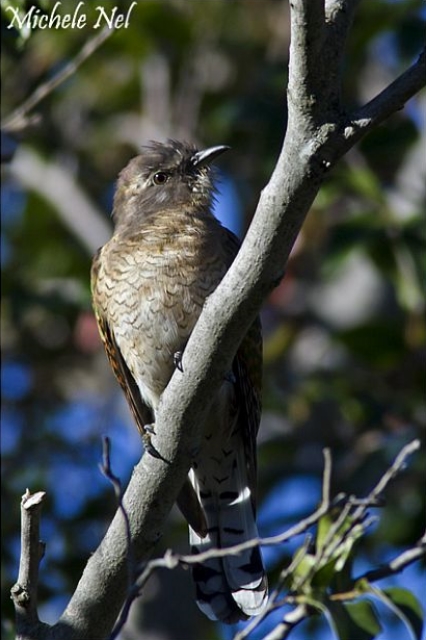 © Michele Nel
© Michele Nel
Juvenile, Kirstenbosch Botanical Gardens, Cape Town
 © steamtrainfan
© steamtrainfanPilanesberg, Kubu Picnic Site
 © BluTuna
© BluTunaKruger National Park, Olifants
 © Michele Nel
© Michele NelJuvenile, Kirstenbosch Botanical Gardens, Cape Town
-
Klipspringer
- Global Moderator
- Posts: 5858
- Joined: Sat Sep 14, 2013 12:34 pm
- Country: Germany
- Contact:
African Emerald Cuckoo
384. African Emerald Cuckoo Chrysococcyx cuprues
Order: Cuculiformes. Family: Cuculidae
Description
8–20 cm; 33–41 g
A forest cuckoo; larger than other glossy green species. Male has sulphur-yellow lower breast and belly contrasting with brilliant emerald-green upper breast, throat and upperparts; vent is barred green and white. Female and juv. are finely barred green and brown above, and green and white below; lacks white eye stripe of juvenile Klaas's cuckoo.
Distribution
Occurs across much of sub-Saharan Africa, excluding extremely arid areas. Senegal and Gambia to South Sudan and Ethiopia, s to Angola and e South Africa. Within southern Africa it is locally common in the Caprivi Strip (Namibia).
Habitat
It generally prefers evergreen and riparian forest, dense woodland and moist savanna, occasionally moving into well-wooded suburbs.
Movements and migrations
Primarily a breeding migrant to southern Africa, staying from September-April, although occasionally remaining in the remaining in the region during winter.
Diet
Mainly eats caterpillars and grasshoppers, supplemented with adult Acraea butterflies and fruit such as Wild peach (Kiggeleria africana), doing most of its foraging in the middle and upper canopy.
Breeding
Promiscuous, territorial brood parasite, with each male defending a display territory and mating with multiple females, which then lay their eggs in the nests of other birds. Egg-laying season is from October-January. It typically lays a single egg in each host nest (destroying one host egg first), laying 3-4 egg clutches on successive days; by the end of the breeding season the female would of laid about 20 eggs in total. The chick kicks out any of the host's eggs or nestlings at about two days old, leaving the nest after approximately 22 days.
The following birds have been recorded as hosts of the African emerald cuckoo:
Camaroptera brachyura (Green-backed camaroptera)
Pogonocichla stellata (White-starred robin)
Phylloscopus ruficapilla (Yellow-throated woodland-warbler)
Platysteira peltata (Black-throated wattle-eye)
Order: Cuculiformes. Family: Cuculidae
Description
8–20 cm; 33–41 g
A forest cuckoo; larger than other glossy green species. Male has sulphur-yellow lower breast and belly contrasting with brilliant emerald-green upper breast, throat and upperparts; vent is barred green and white. Female and juv. are finely barred green and brown above, and green and white below; lacks white eye stripe of juvenile Klaas's cuckoo.
Distribution
Occurs across much of sub-Saharan Africa, excluding extremely arid areas. Senegal and Gambia to South Sudan and Ethiopia, s to Angola and e South Africa. Within southern Africa it is locally common in the Caprivi Strip (Namibia).
Habitat
It generally prefers evergreen and riparian forest, dense woodland and moist savanna, occasionally moving into well-wooded suburbs.
Movements and migrations
Primarily a breeding migrant to southern Africa, staying from September-April, although occasionally remaining in the remaining in the region during winter.
Diet
Mainly eats caterpillars and grasshoppers, supplemented with adult Acraea butterflies and fruit such as Wild peach (Kiggeleria africana), doing most of its foraging in the middle and upper canopy.
Breeding
Promiscuous, territorial brood parasite, with each male defending a display territory and mating with multiple females, which then lay their eggs in the nests of other birds. Egg-laying season is from October-January. It typically lays a single egg in each host nest (destroying one host egg first), laying 3-4 egg clutches on successive days; by the end of the breeding season the female would of laid about 20 eggs in total. The chick kicks out any of the host's eggs or nestlings at about two days old, leaving the nest after approximately 22 days.
The following birds have been recorded as hosts of the African emerald cuckoo:
Camaroptera brachyura (Green-backed camaroptera)
Pogonocichla stellata (White-starred robin)
Phylloscopus ruficapilla (Yellow-throated woodland-warbler)
Platysteira peltata (Black-throated wattle-eye)
-
Klipspringer
- Global Moderator
- Posts: 5858
- Joined: Sat Sep 14, 2013 12:34 pm
- Country: Germany
- Contact:


